Instrumental resources
Catalogue of CeTrA's instrumental resources
- Inductively coupled plasma - sector field mass spectrometer (ICP-SFMS)
- Inductively coupled plasma - quadrupole mass spectrometer (ICP-QMS)
- Inductively coupled plasma - optical emission spectrometer (ICP-OES)
- Mercury analyser
- Fourier-transform infrared spectroscopy (FT-IR) microscope
- Ultra performance liquid chromatograph - high resolution mass spectrometer (UPLC-HRMS)
- High performance ion chromatograph - mass spectrometer (HPIC-MS)
- High performance liquid chromatograph - tandem mass spectrometer (HPLC-MS/MS)
- Ion chromatography - mass spectrometer (IC-MS)
- Gas chromatograph - tandem mass spectrometer (GC-MS/MS)
- Gas chromatograph - mass spectrometers (GC-MS)
- Scanning electron microscope (SEM)
- Atomic force microscope (AFM)
- X-ray diffraction spectrometer (XRD)
- Cavity Ring-Down Spectroscopy
- Scanning Mobility Particle Sizer
- Aethalometer
- Optical Particle Counter
- High-volume aerosol sampler
- Low-volume aerosol sampler
- High-flow cascade impactor
- Vehicle for field monitoring campaigns
- Clean Laboratories
- Col Margherita Atmospheric Observatory
1. Inductively coupled plasma - sector field mass spectrometer (ICP-SFMS)
The high-resolution mass spectrometer Element XR (Thermo Scientific) allows performing interference-free high-precision quantitative determination of elements and isotopic/elemental ratios in liquid samples down to the ultra-trace level.
Thanks to a combination of high-resolution mass filter and counting, analog and Faraday detection modes, the linear dynamic range of the detector extends from sub fg/g (ppq) to over 12 orders of magnitude in solution mode.
The instrument is equipped with a SC-4 autosampler (ESI) for continuous data acquisition and APEX (ESI) desolvating nebulizer systems for further reduction of solvent-based interferences such as oxides and hydrides.
- Applications: quantitative multi-elemental and isotopic analysis at trace and ultra-trace levels in environmental samples, geological analysis, material sciences, conservation sciences, forensics, clinical samples, food and biological materials.
- Experimental services: EAC-06: Ultratrace elemental analysis


2. Inductively coupled plasma - quadrupole mass spectrometer (ICP-QMS)
The instrument iCAP-RQ (Thermo Scientific) is dedicated to the quantitative determination of trace elements and elemental ratios in liquid samples. The system is equipped with a Qcell technology assembly which can be run using He as collision gas and/or H2 as reaction gas to achieve reduction of spectral interferences. Additional accessories include an autosampler ASX-560 (Cetac) for high-throughput analysis, sample introduction kit for the analysis of HF mineralized samples and cone inserts for high sensitivity/robust/high matrix analysis. The instrument allows performing highly reproducible quantitative multi-elemental determinations over 9 orders of magnitude in concentration in a variety of sample matrices across the entire mass range.
- Applications: quantitative multi-elemental analysis from major to low-trace levels in environmental samples, geological analysis, material sciences, conservation sciences, forensics, clinical samples, food and biological materials.
- Experimental services: EAC-02: Microplastics quantitative analysis
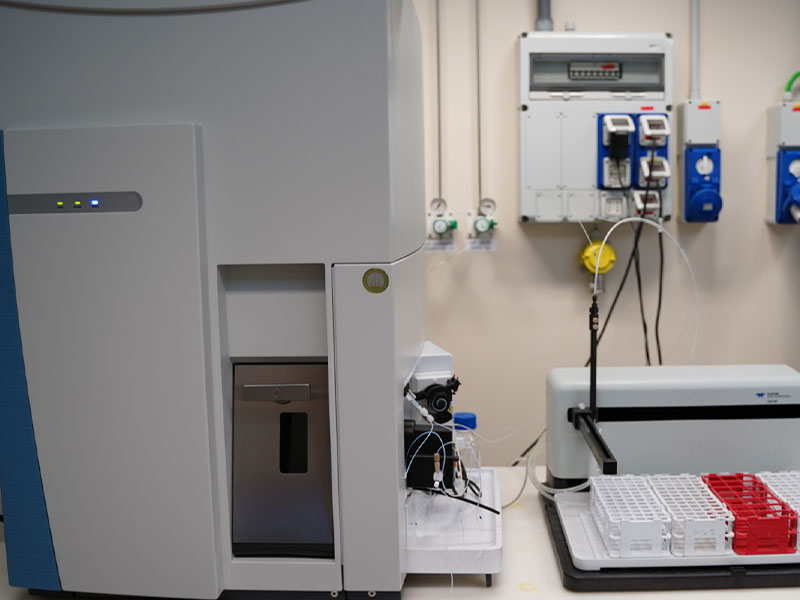
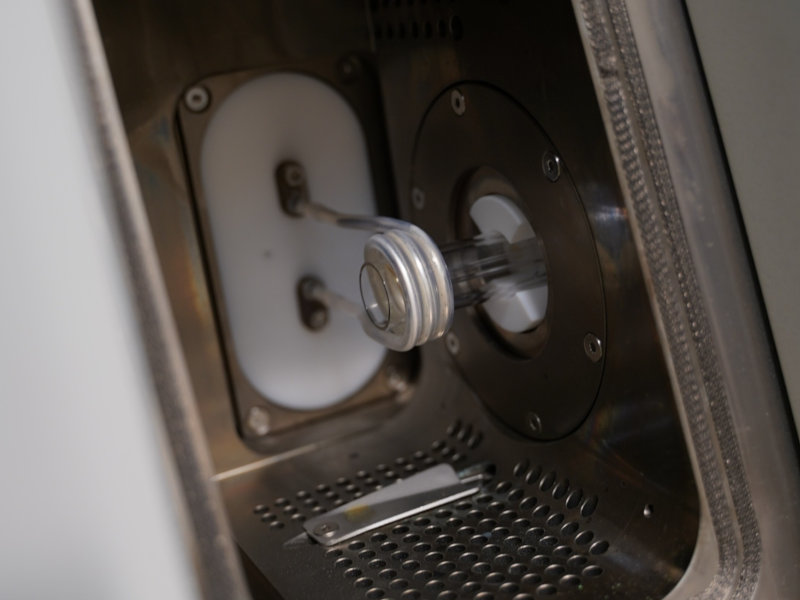
3. Inductively coupled plasma - optical emission spectrometer (ICP-OES)
The instrument iCAP 7400 (Thermo Scientific) is dedicated to the quantitative determination of major-to-trace elements and elemental ratios in liquid or (appropriately) dissolved samples. The system is equipped with high-efficiency light transmission system, radial or duo (radial + axial) plasma view configurations to suit a wide variety of sample types and elements of interest and a simultaneous wavelength acquisition system. Elemental concentrations can be determined with detection limits in the ppb or sub-ppb level with high instrumental precision and long-term signal stability even in complex matrices or at consistently high levels with minimized memory effects. Additional accessories include an autosampler ASX-560 (Cetac) for high-throughput analysis.
- Applications: quantitative multi-elemental analysis from major to trace levels in environmental samples, geological analysis, material sciences, conservation sciences, forensics, clinical samples, food and biological materials.
- Experimental services: EAC-02: Microplastics quantitative analysis
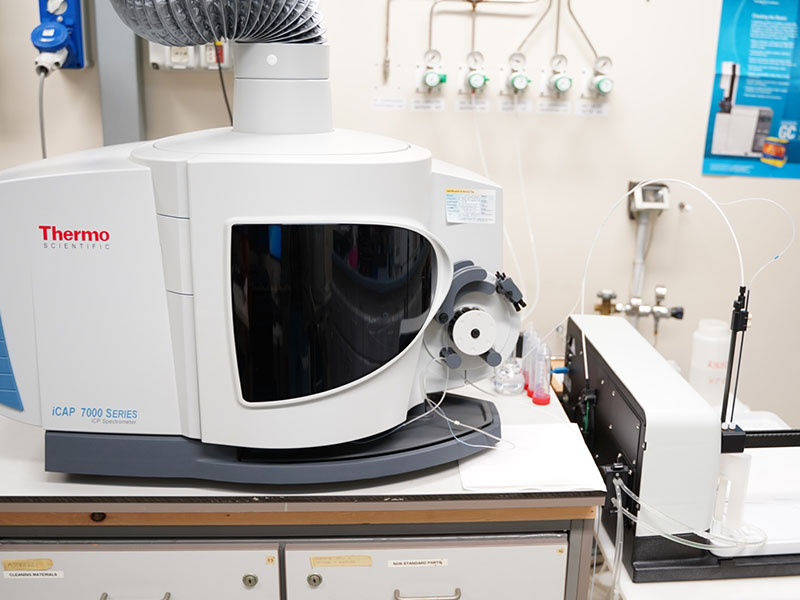
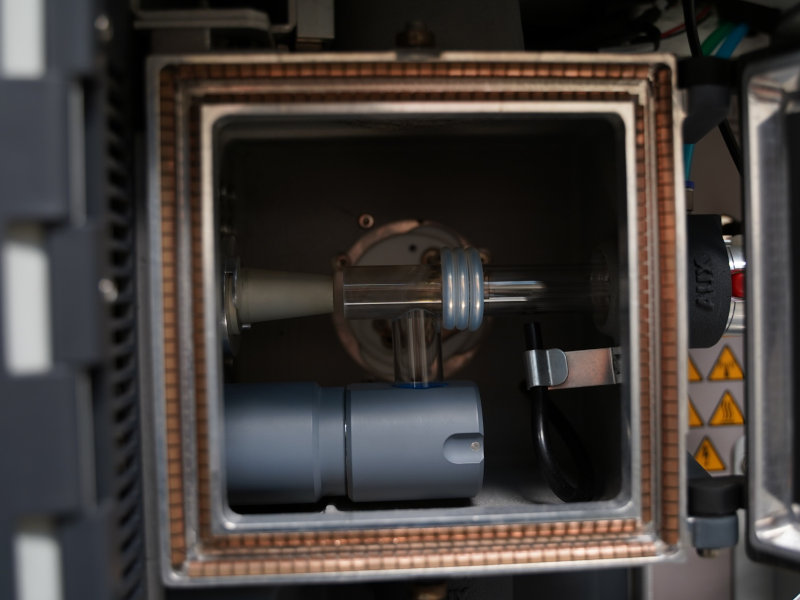
4. Mercury analyser
The Mercur DUO plus (Analytik Jena) is an atomic absorption (AAS) and atomic fluorescence (AFS) spectrometer specifically designed and dedicated to the analysis of mercury in compliance with the standards EPA, EN and ISO. An integrated module with two gold collectors allows simple or cascade enrichment of mercury (according to EPA method 1631) to achieve determination limits from the low ppt to the ppq range with high method robustness, depending on the type of sample and configuration. Additional accessories include an autosampler AS-FD for high-throughput analysis.
- Applications: determination of mercury in drinking and natural waters, wastewater, soil and sediments, rocks, ashes, biological fluids, food, beverages, quality control of materials.
- Experimental services: EAC-08: Mercury analysis, EAC-12: High-altitude atmospheric observatory

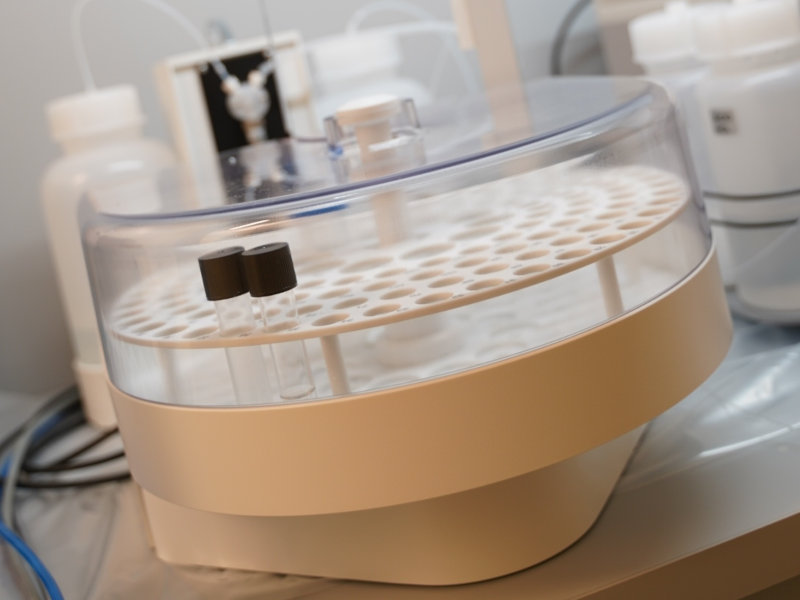
5. Fourier-transform infrared spectroscopy (FT-IR) microscope
The instrument is an infrared microscope Nicolet iN10 (Thermo Scientific) integrating a high-resolution CCD optical camera and a FT-IR spectrometer and is designed to perform microanalysis with lateral resolution down to a 50-microns at room temperature or a few microns with liquid nitrogen cooling. The instrument is equipped with motorized stage, MicroTip ATR device for direct contact sampling and analysis of fine structures (down to 3 microns), motorized visible polarizer for visual inspection, MTC-A detector with spectral range 7800–650 cm-1 and the dedicated software package OMNIC Picta for spectral identification of pure compounds and mixtures. Acquisition can be performed in transmission, reflection, or ATR modes. Particles analysis can also be performed to extract species-specific distributions of morphological parameters (size, shape).
- Applications: microspectroscopy, material identification, packaging and laminate, coating, active pharmaceutical ingredient mixture distribution mapping, identification of contaminants, microplastics identification and characterization.
- Experimental services: EAC-05: Polar organics targeted analysis


6. Ultra performance liquid chromatograph - high resolution mass spectrometer (UPLC-HRMS)
The instrument consists of an ultra-high performance liquid chromatograph (UPLC) Vanquish Flex (Thermo Scientific) equipped with a analytical pump and autosampler for high throughput, coupled to an Orbitrap Exploris 120 mass spectrometer (Thermo Scientific). The ionization is obtained using an ESI and APCI ion source (Thermo Scientific). The MS/MS acquisition is downstream to a collision induced dissociation (CID) fragmentation and provides accurate mass measurement (<5 ppm) with high mass resolution (120,000 ) and sensitivity. This instrument can carry out quantitative target analysis, suspect screening and untageted analysis for environomental, metabolomics and clinical applications for the identification of unexpected compounds.
- Applications: environmental, metabolomics, suspect screening and untargeted analysis of compounds in complex liquid media.
- Experimental services: EAC-04: Polar organics untargeted analysis


7. High performance ion chromatograph - mass spectrometer (HPIC-MS)
The instrumentation consists of a high performance ion chromatograph ICS-5000 Standard Bore and Microbore System (Dionex, Thermo Scientific) coupled to a single quadrupole mass spectrometer MSQ Plus (Thermo Scientific) and is dedicated to the quantitative determination of and water-soluble and ionic organic/inorganic compounds in liquid media. The chromatograph can operate up to 5000 psi to achieve high performance separation and is equipped with an eluent generator ICS 5000EG (Dionex, Thermo Scientific) configured with carbonate or hydroxide eluents for anions and metanesulfonic acid (MSA) for cations determination, suppressors ASRS 500 or CCES 300 (Thermo Scientific) to remove the salts form mobile phase before entering the MS source, and CD conductivity detector. The mass spectrometer is equipped with an electrospray source (ESI).
- Applications: determination of inorganic ions and water-soluble and ionic organic compounds (e.g. sugars, organic acids) in water, sediment, soil, atmospheric aerosol, food and beverages, composite materials.
- Experimental services: EAC-05: Polar organics targeted analysis

8. High performance liquid chromatograph - tandem mass spectrometer (HPLC-MS/MS)
The instrumentation consists of a 1100 series HPLC system (Agilent Technologies) coupled to an API 4000 triple quadrupole mass spectrometer (Applied Biosystems/MDS SCIEX) and is dedicated to the identification and quantitative determination of low abundance organic compounds in liquid media. The HPLC is equipped with a vacuum degasser, a binary HPLC pump system, an autosampler and a thermostatic column compartment. The mass spectrometer is equipped with a Turbo V source for flexible exchange between atmospheric pressure chemical ionization (APCI) source and Turbolon spray probe, capable of achieving maximized ionization efficiency and minimized chemical noise and instrumental drift.
- Applications: identification and quantitative determination of low abundance organic compounds in clinical samples (e.g. pesticides/drug residues), forensic toxicology, environmental matrices, food and beverages, composite materials.
- Experimental services: EAC-05: Polar organics targeted analysis

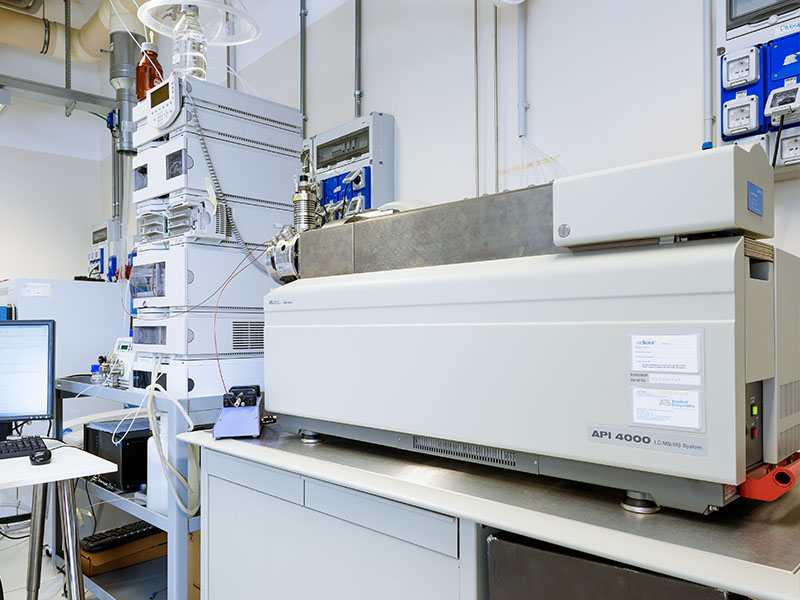
9. Ion chromatography - mass spectrometer (IC-MS)
Ion chromatography system ICS-6000 HPLC Dual Pump with AS-AP thermostatic autosampler coupled to ISQ-EC single quadrupole mass spectrometer (Thermo Scientific Dionex). Its Reagent-Free IC components, including RFIC-EG for automated eluent generation and self-regenerating suppression, offer enhanced convenience and efficiency. Using only deionized water, the system ensures precise eluent concentrations tailored to specific analytical requirements, contributing to superior accuracy for the detection and quantification of low-molecular-weight ions with limits of detection (LOD) in the single-digit-parts-per-billion (ppb) range. The system is dedicated to the targeted quantitative analysis of polar compounds in environmental matrices and is particularly well suited for the analysis of atmospheric aerosols collected in remote and alpine areas.
- Applications: environmental water monitoring; analysis of inorganic anions (e.g., nitrate, nitrite, sulfate, chloride); detection of organic acids (e.g., formate, acetate, oxalate); trace determination of haloacetic acids in drinking water; characterization of ionic degradation products of pesticides; investigation of ionic species in atmospheric aerosols; analysis of industrial effluents and wastewater; source apportionment studies involving ionic tracers.
- Experimental services: EAC-05: Polar organics targeted analysis

10. Gas chromatograph - tandem mass spectrometer (GC-MS/MS)
The instrument consists of a GC Trace 1310 (Thermo Scientific) equipped with user-exchangeable instant connect injector and detector modules, coupled to a TSQ 9000 triple quadrupole MS/MS detection system. The ExtractraBrite ion source is fully removable without breaking the vacuum probe interlock (VPI) to achieve fast operationality and switching from electron ionization (EI) to chemical ionization (CI). For the highest level of sensitivity the Advanced Electron Ionization (AEI) source can be configured to reach instrument detection limits into the attogram range. The instrument is suited for quantitative targeted and untargeted analysis of volatile/semi-volatile compounds.
- Applications: SPE samples, pesticides residuals, persistent organic pollutants in food and beverages, waters, clinical samples, forensic sciences.
- Experimental services: EAC-01: VOCs and SVOCs analysis
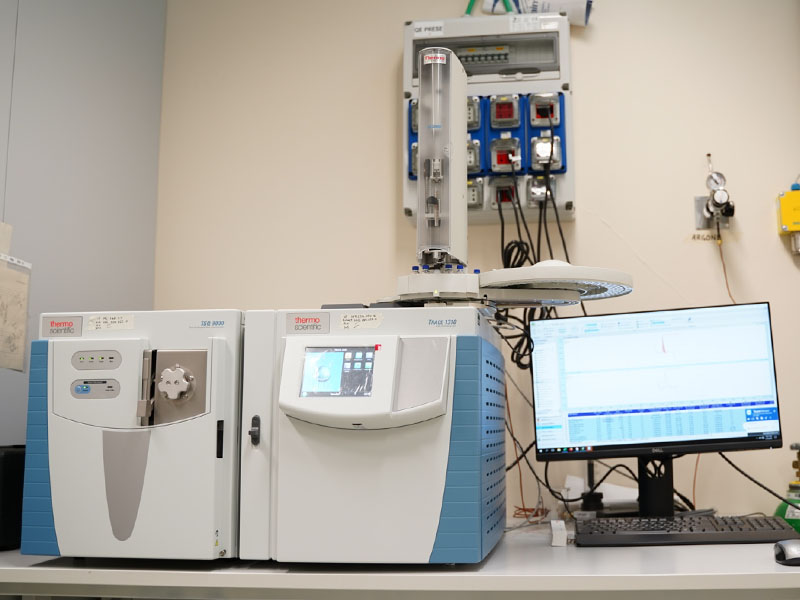

11. Gas chromatograph - mass spectrometers (GC-MS)
Three GC-MS analysers are available at the Centre.
- A single quadrupole 7890A-5975C GC-MS instrument (Agilent Technologies), equipped with a 150 vial positions autosampler (7693A, Agilent Technologies) and electron ionization source operated in positive mode. The instrument allows qualitative screening and quantitative determination of pesticides, lipids, persistent organic pollutants in environmental and biological matrices (aerosol, water, soil, sediment, biota).
- A single quadrupole 7890A-5975C Cryo-GC-MS instrument (Agilent Technologies), equipped with a Unity2 (Markes International) thermal desorption and with a 15 vials autosampler (G4513A, Agilent Technologies). The instrument is suited for the analysis of volatile and semi-volatile organic compounds (VOCs and SVOCs) in environmental matrices (indoor and outdoor air quality), food, forensics, consumer and other application fields (flavours and fragrances).
- A PyGC-MS instrument 6890-5973N (Agilent Technologies), equipped with a pyrolizer (CDS 5150). The instrument is suited for qualitative analysis of volatile (persistent organic pollutants, pesticides, etc.) and non-volatile compounds (paints, adhesives, plastics, synthetic fibres), in environmental, clinical, and forensic samples.
- Applications: persistent organic pollutants in food and beverages, waters, clinical samples, forensic sciences, volatile species of interest in climate, environmental and food science.
- Experimental services: EAC-01: VOCs and SVOCs analysis, EAC-02: Microplastics quantitative analysis


12. Scanning electron microscope (SEM)
Field emission (FE) SEM Zeiss Ʃigma|VP equipped with a thermal field emission gun (Schottky emitter) source. The electron-optical column is a GEMINI design, and the instrument can work in variable-pressure (VP) mode, with pressures adjustable from 1 to 133 Pa, avoiding the need to coat non-conductive samples. The instrument is provided with a range of imaging detectors:
- conventional Everhart-Thornley detector for secondary electrons (SE), with high collection efficiency;
- 4-sector semiconductor detector for back-scattered electrons (BSE);
- high-resolution in lens detector for SE, which (together with the electron source and the column design) allows a nominal resolution down to 1.5 nm @ 15 kV.
The machine is also equipped with a Bruker Quantax 200, an energy dispersive X-ray spectrometry (EDS) system of the SDD type, with a 30 mm2 window which allows fast spectra and X maps acquisition; analytical resolution ≤127 eV @ 5.6 keV.
- Applications: analysis of composition, morphology and size distributions in vacuum and VP mode; ceramics; metals; glass; aerosol, mineral and biological particles; chemical (elemental) imaging.
- Experimental services: PCCM-01: Surface microanalysis
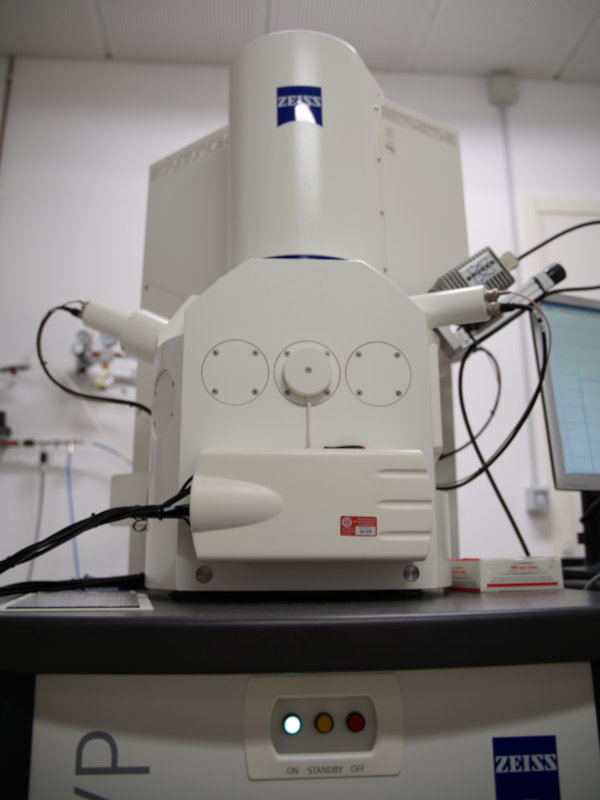

13. Atomic force microscope (AFM)
Dimension Icon (Bruker) is a tip-scanning AFM platform allowing nanoscale imaging. The analysis can be conducted in ambient and liquid environments. Depending on the requirements, three main modes with suitable probes are available:
- contact mode;
- tapping mode;
- non-contact mode.
In addition to the morphology of the samples, a wide variety of properties can be investigated. Nano-electrical properties of the materials with a spatial resolution of the order of 10 nm or less (depending on the AFM probe) can be investigated by means of conductive AFM (c-AFM) and Kelvin probe force microscopy (KPFM). The c-AFM allows to obtain topography and electrical conductivity maps of the samples by using a conductive tip. Nanomechanical analysis is also available (PeakForce-QNM®) by means of PeakForce Tapping® technology.
- Applications: molecular engineering, surface chemistry, semiconductors and polymeric material science and cellular biology.
- Experimental services: PCCM-02: Surface nanotopography analysis

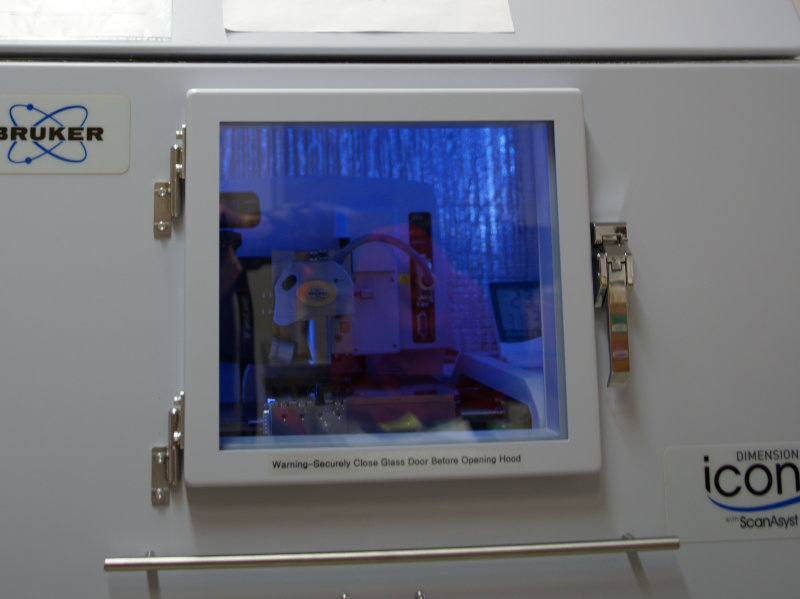
14. X-ray diffraction spectrometer (XRD)
The Empyrean Series 3 (Malvern Panalytical) is an X-ray platform for the structural analysis of powders, thin films, nanomaterials and solid materials in a single instrument. Standard wide angle X-ray scattering (WAXS) and ultra-small angle X-ray scattering (USAXS) modes are available for analysis in air and in liquid. The instrument is equipped with a point-like X-ray source, allowing to map samples with a spatial resolution of about 300 μm. In addition, grazing-incidence GISAXS and GIWAXS geometries are also implemented for the analysis of films and nanostructures deposited/grown on different substrates.
- Applications: characterization of crystalline materials, identification of fine-grained minerals, sample purity, textural measurements, thin films characterization.
- Experimental services: PCCM-03: Phase composition analysis


15. Cavity Ring-Down Spectroscopy
The Cavity Ring-Down Spectroscopy (CRDS) L2140-i isotopic water analyzer provides high-precision measurements of δ18O, δ17O, and δD in water vapor. The instrument is equipped with autosampler (model A0325) and vaporizer (model A0211), enabling high precision measurements (<0.025‰ for δ18O) of the isotopic composition of water, although yielding good throughput (~20 samples per day). The volume of water required for a single sample analysis is small (~20 μl), although the minimum sample manageable by the autosampler is ~100 μl. The instrument runs in a wide range of humidity (specs. 1000 – 50000 ppm) and atmospheric pressure (40 to 133 kPa, absolute), therefore it can be natively used to measure the isotopic composition of atmospheric water vapor at sea level, on the ground, in high altitude mountains and in aircraft up to 6000m ASL.
- Applications: stable water isotope analysis of freshwater, ice core, snow and water vapor. Paleoclimate (e.g. isotope thermometry), ecohydrology (e.g. quantification of evapotranspiration fluxes from soils and plants), hydrology (e.g. investigation of ground water recharge areas), forensics (e.g. analysis of water source region in food, prior separation), atmospheric physics (e.g. tracking air mass mixing).
- Experimental services: EAC-14: Water isotopes analysis

16. Scanning Mobility Particle Sizer
The Scanning Mobility Particle Sizer (SMPS) 3938 spectrometer is a modular system for measuring particle size distributions in air. The system consists of an electrostatic classifier with a scanning mobility column (DMA) and a condensate particle counter (CPC). This allows the measurement of size distributions and numerical concentrations of particles from 1 nanometer to 1 micron in size with a size resolution of 64 channels per decade for a total of up to 167 channels (between 2.5 nm and 1 µm). The Aerosol Instrument Manager (AIM) software controls the operation of the SMPS 3938 spectrometer, allowing data to be processed by number, size, mass, and volume, and data to be exported to other software applications.
The system is equipped with an atmospheric particulate sampling system.
- Applications: atmospheric science; air quality monitoring; combustion research; nanoparticle characterization in environmental and engineered contexts; high-resolution measurement of submicron aerosol particle size distributions.
- Experimental services: EAC-09: Airborne ultrafine particles sizing, EAC-12: High-altitude atmospheric observatory
17. Aethalometer
Aethalometer AE33 for online continuous measurement of airborne black carbon. The aerosol-laden air stream is drawn through a spot on a filter tape at a measured flow rate. The analysis of the black carbon is made following the two-spot technology: sensitive detectors measure the intensities of light transmitted through an un-exposed portion of the tape, acting as a reference; versus the collecting spot. The measured particles are divided by the inlet flow and the result is reported as concentration.
Additionally, the analysis is made at 7 optical wavelengths spanning the spectrum 370, 470, 520, 590, 660, 880 and 950 nm and with a time resolution to 1 second. The instrument is equipped with a touch screen controller, and it is remotely accessible.
- Applications: real-time measurement of aerosol optical properties; quantification of aerosol climate direct effect via light absorption; monitoring of atmospheric black carbon concentrations; contribution to climate, air quality, and cryosphere impact assessments; spectral analysis of aerosol absorption to differentiate fossil fuel and biomass burning sources.
- Experimental services: EAC-12: High-altitude atmospheric observatory

18. Optical Particle Counter
The optical particle counter (OPC) EDM 264 Eco pursues an automatic continuous analysis and integrates concentration reading and particle size distribution in 31 size classes between 0.25 and 35 µm, equidistant, with a simultaneous real-time determination of PM mass in 12 particle size fractions (inhalable, thoracic, and respirable fractions in accordance with EN 481; PTS, PM10, PM4, PM2.5, PM1, and PM coarse). The instrument is installed in a transportable outdoor cabinet. The spectrometer is completed with a GPS system; heated 50 cm probe with u-Sigma-2 input; T, P, and RH weather sensor; USB interface, Ethernet (TCP/IP); GRIMM 1179 software.
- Applications: high-frequency measurement of atmospheric aerosol particle size distribution; estimation of aerosol climate impact; assessment of aerosol atmospheric lifetime; investigation of natural and anthropogenic aerosol sources; characterization of aerosol burden in mountain regions.
- Experimental services: EAC-12: High-altitude atmospheric observatory
19. High-volume aerosol sampler
The High-volume aerosol sampler DHA-80 is a fully automatic systems to sample dust and aerosol particles for later assessment and analysis. The sampler operation range in standard execution is 100 to 1.000 liters per minute (6 to 60 m³/h). The instrument has a magazine of 15 filters stretched in filter holders. They are automatically changed to the flow position at the pre-set time. The sampling can be programmed with starting time and duration but also for more complex applications using cycles for interrupted sampling or wind dependent sampling when the instrument is equipped with optional wind sensor. The field housing is suited for outdoor installation. It is easy to transport and because of a good sound insulation very quiet.
- Applications: automatic collection of aerosol samples on quartz fiber filters, specifically designed for remote areas.
- Experimental services: EAC-10: Atmospheric PM sampling, EAC-12: High-altitude atmospheric observatory

20. Low-volume aerosol sampler
The Gemini sequential sampler by DadoLab is a practical, portable and user-friendly aerosol sampler. It incorporates a multifunctional central unit (MPC) capable of managing sequential sampling across both single and dual channels. The sampler has a mass of approximately 35 kg, exclusive of the pump and the supporting stand. The Gemini in the dual-channel version can accommodate up to 42 white/exposed filters samples in total. The MPC unit is outfitted with contemporary communication interfaces, including USB, RFID, Bluetooth, and mobile network, thereby guaranteeing comprehensive data traceability. Additionally, the Gemini is designed with a forced internal air recirculation system, which assists in sustaining the ventilation tube and exposed samples at ambient room temperature.
- Applications: automatic collection of aerosol samples on quartz fibre filters.
- Experimental services: EAC-10: Atmospheric PM sampling, EAC-12: High-altitude atmospheric observatory

21. High-flow cascade impactor
The Model 131B High-Flow Cascade Impactor by TSI is designed for the sampling of low-concentration particles, such as in pristine environments, to collect a larger mass per stage compared to conventional other conventional impactors or to obtain samples in shorter sampling intervals. The impactor is available with 6 stages, covering an aerodynamic size range from 0.25 to 10 µm. Particles are deposited onto 75 mm substrates that can be analysed for mass, chemical analysis, or microscopy. The Model 131B is constructed from anodized aluminium to ensure lightness, durability, and nozzle dimensional stability. The main characteristics include: a sampling flow rate of 100 L/min, a sharp particle size cut-off characteristic, micro-orifice plates designed for low flow resistance and reduced particle bounce and re-entrainment, six impactor stages with nominal cut points ranging from 250 nm to 10 µm, in addition to a 90 mm final filter. The 75 mm impactor substrates are designed to deposit particles in four separate quadrants for easy substrate division. Additionally, the design of the instrument guarantees a low inter-stage losses.
- Applications: atmospheric aerosol analysis for size distribution and composition in high mountain sites.
- Experimental services: EAC-10: Atmospheric PM sampling, EAC-12: High-altitude atmospheric observatory
22. Vehicle for field monitoring campaigns
Vehicle configured and customized for use as a mobile laboratory unit (mobile environmental monitoring unit). The vehicle is a Ford Nuovo Custom (DFBF) Transit Van Trend 2.0 Ecoblue 136 HP A8, specifically selected and modified with a custom configuration to allow the transport and/or onboard installation of dedicated scientific instrumentation for environmental analysis. It is intended for potential deployment as a mobile laboratory (mobile unit for environmental monitoring). The van provides suitable volume, engine power, and all-wheel drive (4x4) capabilities to support the transport of materials and conduct environmental monitoring campaigns, including in remote or high-altitude areas.
- Applications: transport of materials and execution of environmental monitoring campaigns.
- Experimental services: EAC-11: Mobile laboratory
23. Clean Laboratories
The facility includes two Clean Laboratories dedicated to the ultra-clean manipulation/preparation of samples for inorganic and organic analysis, respectively.
The inorganic clean laboratory is entirely made of plastic-coated materials designed for the low release of airborne particles, while the organic clean laboratory is entirely made of steel materials and components designed to minimize the release of organic substances and maximize the effectiveness of decontamination procedures. The inorganic clean laboratory consists of 4 rooms ISO 6 equipped with laminar flow benches (one is additionally equipped with an extractor hood and glove box for the preparation of atmospheric aerosols filters), 1 room ISO 5 equipped with laminar flow bench and 1 room ISO 4. The organic clean laboratory consists of 1 room ISO 7 for intermediate sample preparation, 2 rooms ISO 6 equipped with laminar flow benches, 1 room ISO 5 equipped with laminar flow bench and 1 room ISO 4.
All the clean rooms are at overpressure increasing as function of their class, equipped with ceiling installed HEPA filters for continuous filtering of the internal air and dedicated internal production systems of Milli-Q water (Elga LabWater).
- Applications: contamination-free manipulation and processing of samples for trace and ultra-trace level analysis of inorganic or organic species.
- Experimental services: EAC-13: Clean laboratories
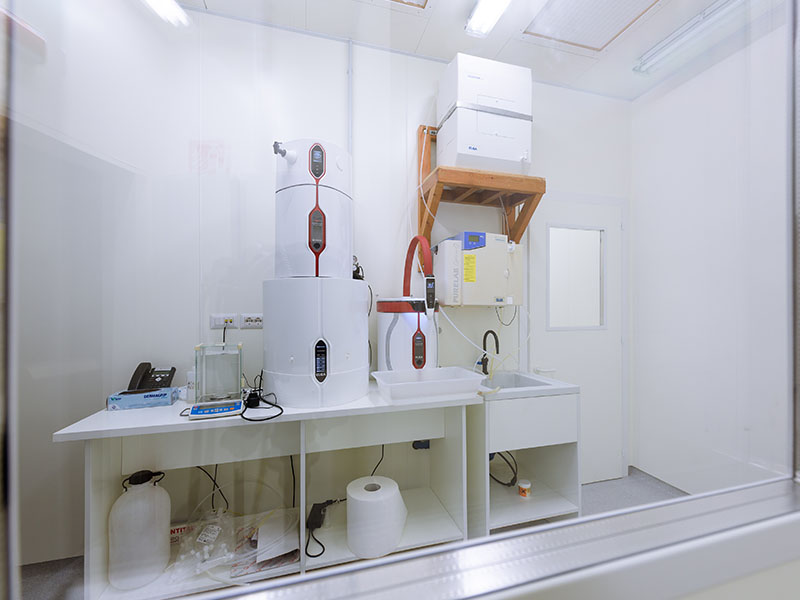
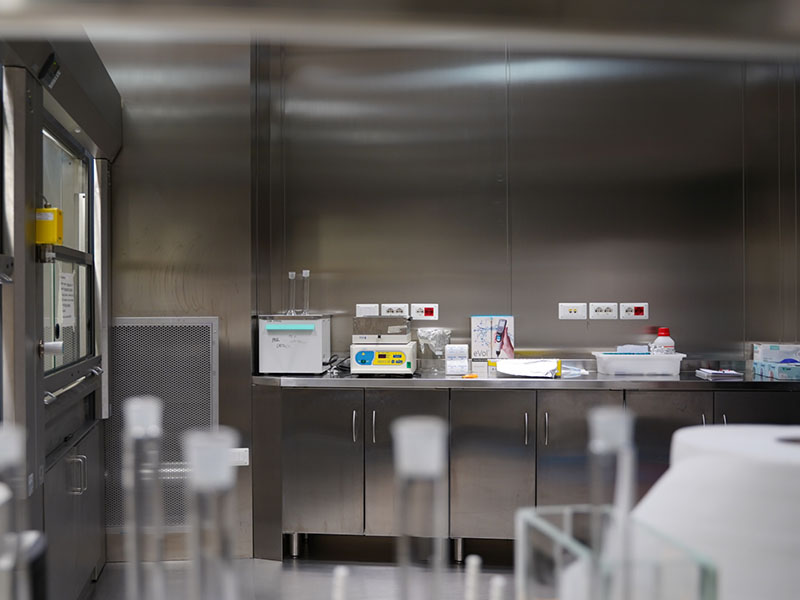
24. Col Margherita Atmospheric Observatory
The high-altitude observatory of Col Margherita (MRG) is currently the only station in the Eastern Alps providing measurements of atmospheric pollutants and the main meteorological parameters. The station is located on the top of Col Margherita at 2543 m a.s.l. (46.36 ° N - 11.79 ° E) in the municipality of Falcade (Belluno), near the border between Veneto and Trentino Alto Adige, in the mountain scenery of the Belluno Dolomites (UNESCO World Heritage Site since 2009). The Col Margherita observatory is part of the GAW-WMO stations network as a "GAW Regional station" since December 2019.
- Applications: air quality monitoring, meteorological monitoring, atmospheric pollutants, atmospheric aerosols.






